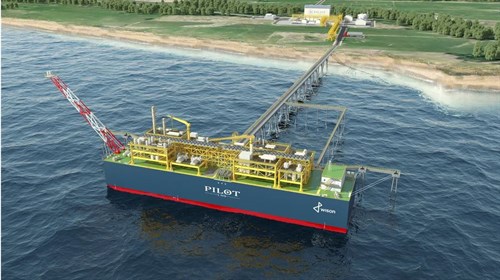Pilot LNG announces Galveston LNG bunker port
Pilot LNG LLC (Pilot LNG), a clean energy solutions company focused on providing infrastructure solutions to supply new markets with clean-burning natural gas, announced the filing of its regulatory applications paving the way for the development of the region’s first dedicated LNG bunker terminal, Galveston LNG Bunker Port, to be located on Pelican Island. The company expects a Final Investment Decision on the project in the second half of 2021 and operations starting in 2024.
 |
“Pilot LNG’s Galveston LNG Bunker Port will provide clean-burning LNG to one of the US’s largest Port complexes,” said Pilot LNG Chief Executive, Jonathan Cook. “The proposed Galveston LNG Bunker Port would provide the necessary infrastructure to supply the growing market for LNG marine fuel, substantially reducing marine emissions and cutting shippers’ fuel costs at the same time,” Cook added.
The facility infrastructure will be designed around FLNG technology to be engineered, and constructed by Pilot partner, Wison Offshore & Marine. “Wison is pleased to be part of this breakthrough U.S. project by designing and building the liquefaction unit, that will supply LNG to the end-user market in the Galveston, Houston and Texas City port complex”, stated Vivian Li, head of Wison Offshore & Marine in North America. “Since delivering the world’s first FLNG facility currently operating in Argentina, Wison has developed numerous floating solutions across the LNG value chain, with a focus on promoting a cleaner energy infrastructure alternative to the global market.”
As international regulators tighten emissions standards, the maritime industry is increasingly turning towards LNG as the marine fuel of choice due to its significantly lower emissions profile and cost competitiveness; however, additional LNG bunkering infrastructure is needed before widespread adoption can occur. Specifically, IMO 2020, which limits sulfur content to less than 0.5% m/m (mass by mass) globally and to less than 0.1% m/m in designated Emission Control Areas (ECAs) including US coastal waters and the Galveston Bay area, makes it substantially harder for traditional marine fuels to comply with regulations and more expensive for shippers to operate.
LNG when used as a marine fuel significantly reduces vessel emissions, including eliminating virtually all SOx emissions without the need for expensive scrubbers or other technologies and achieves approximately 80% - 90% NOx emission reductions compared to other marine fuels. In addition, LNG produces virtually no particulate matter, altogether resulting in a significantly cleaner fuel.
The Galveston Bay area, which encompasses the industrial Ports of Houston, Texas City and Galveston, is an ideal location to add LNG bunkering infrastructure with over 10,500 deep-water vessel visits in 2019, over 133,000 tug/tow movements on the Houston Ship Channel, and the nation’s fourth busiest cruise terminal.
In recent years, LNG as a marine fuel has experienced significant growth around the world, particularly in Europe and Asia; however, the US is only now starting to see widespread adoption. New LNG bunkering infrastructure in the US is needed to facilitate the continued rapid global adoption of clean burning LNG marine fuel.

- ADNOC Gas awards $2.1 B in contracts to enhance LNG supply infrastructure
- U.S. Department of the Treasury releases final rules for clean hydrogen production tax credit
- Tecnimont to build waste-to-biogas plant to fuel local kitchens in India
- Indonesia regulator confirms disruption at bp's Tangguh LNG project
- Topsoe, Aramco sign JDA to advance low-carbon hydrogen solutions using eREACT™



Comments